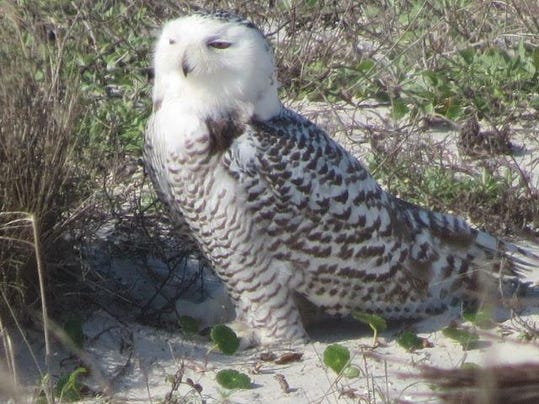

Elizabeth Weise, USATODAY5:30 p.m. EST January 6, 2014
Freezing temperatures are causing some bird species to fly farther south for the winter. Look for surprising species at a bird feeder near you.
This week’s intense cold could result in some surprising bird sightings, experts say. For some species it’s just too cold to stay put. Others can’t get to their usual food sources. Which could mean some great bird watching at a bird feeder near you.
The current deep freeze is driving waterfowl south because inland lakes they rely on are freezing over. Both eagles and ducks require open water.
“If you’re a duck and the lake you’re on is going to freeze, you have to move south,” said Brian Sullivan, a project leader for ebird.org, a site run by the Cornell University Lab of Ornithology that tracks bird sightings internationally.
Look for ducks, red-breasted Merganser, eiders and common goldeneyes to show up in areas where they normally don’t, said Jason Berry, a conservation officer with the American Bird Conservancy in Washington, D.C.
Robins and blackbirds should be moving south in response to this weather right now, said Sullivan. From sightings on ebird.org, it looks as if snow geese are also “vacating the U.S.-Canada border region for points south,” he said.
Robins and woodcocks require unfrozen ground to feed, so they will move south until they find it, said Bryan Watts, director of the Center for Conservation Biology at the College of William and Mary in Williamsburg, Va.
The cold is also a problem for ground-feeding birds. “If you get even a little snow and it’s not melting, the birds can’t feed,” Berry said. They include sparrows, snow buntings and Lapland longspurs.
While some species move in the face of cold or frozen conditions, others don’t. Called obligate wintering species, “they have to huddle up where they are. Once they have made their fall migration, they’re more rigid about their range,” Watts said.
White-throated sparrows, hermit thrush, winter wrens and brown creepers won’t be moving much, he said.
But many birds are, which means “you can have some really cool birds showing up at your feeders,” Berry said.
Because of that people who have bird feeders might need to check them more often than they normally do. Even birds that do just fine in the cold burn a lot more calories just to stay alive when the temperature really drops, he said.
“You’ll have bird feeders that might normally last for two or three days that are gone in just a few hours,” Berry said.
And don’t forget that water in bird baths freezes, too.
“It’s going to freeze up in a couple of hours, so either check and throw out the ice and put in new, or you can even buy little bird heaters for bird baths to keep them ice free,” he said.
Among things not weather-related are sightings of snowy owls as far south as Florida, Watts said.
The owls live in the high arctic. “So what we think is harsh down here isn’t really harsh to them,” said Sullivan. “If they have something to eat, the cold doesn’t really bother them.”
Instead, the snowy owls are moving down the East Coast because of a population explosion back home.
The owls feed on lemmings, voles and other small, mice-like creatures. Every few years the lemming population surges. That extra food in turn leads to a larger-than-normal crop of snowy owls hatching and surviving.
This was a record year for lemmings and afterwards for snowy owls. So much so that there aren’t enough hunting grounds for them in the north, so they’re moving south.
“We’re seeing them in record numbers,” said Watts. “We probably haven’t seen an irruption like this in a century. It’s a real craze; people are seeing them as far south as Jacksonville, Fla.”
There have been more than 1,000 reported sightings in the United States, according to ebird.org.
But they won’t stay. The owls will fly home to the arctic in March or April, Watts said
